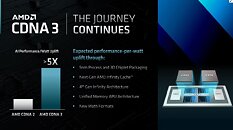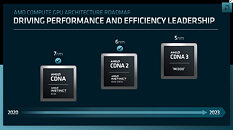- Joined
- Oct 9, 2007
- Messages
- 47,682 (7.42/day)
- Location
- Dublin, Ireland
| System Name | RBMK-1000 |
|---|---|
| Processor | AMD Ryzen 7 5700G |
| Motherboard | Gigabyte B550 AORUS Elite V2 |
| Cooling | DeepCool Gammax L240 V2 |
| Memory | 2x 16GB DDR4-3200 |
| Video Card(s) | Galax RTX 4070 Ti EX |
| Storage | Samsung 990 1TB |
| Display(s) | BenQ 1440p 60 Hz 27-inch |
| Case | Corsair Carbide 100R |
| Audio Device(s) | ASUS SupremeFX S1220A |
| Power Supply | Cooler Master MWE Gold 650W |
| Mouse | ASUS ROG Strix Impact |
| Keyboard | Gamdias Hermes E2 |
| Software | Windows 11 Pro |
AMD in its 2022 Financial Analyst Day presentation unveiled its next-generation CDNA3 compute architecture, which will see something we've been expecting for a while—a compute accelerator that has a large number of compute units for scalar processing, and a large number of x86-64 CPU cores based on some future "Zen" microarchitecture, onto a single package. The presence of CPU cores on the package would eliminate the need for the system to have an EPYC or Xeon processor at its head, and clusters of Instinct CDNA3 processors could run themselves without the need for a CPU and its system memory.
The Instinct CDNA3 processor will feature an advanced packaging technology that brings various IP blocks together as chiplets, each based on a node most economical to it, without compromising on its function. The package features stacked HBM memory, and this memory is shared not just by the compute units and x86 cores, but also forms part of large shared memory pools accessible across packages. 4th Generation Infinity Fabric ties it all together.


AMD is claiming a 500% (or 5 times) AI compute performance/Watt uplift over CDNA2, thanks to the combination of 5 nm processor for the compute dies, an advanced 3D chiplet packaging technology, 4th Gen Infinity Fabric, new math computing formats, Infinity Cache on the compute dies, and a unified memory architecture. The company is working toward a 2023 debut of CDNA3.
View at TechPowerUp Main Site
The Instinct CDNA3 processor will feature an advanced packaging technology that brings various IP blocks together as chiplets, each based on a node most economical to it, without compromising on its function. The package features stacked HBM memory, and this memory is shared not just by the compute units and x86 cores, but also forms part of large shared memory pools accessible across packages. 4th Generation Infinity Fabric ties it all together.


AMD is claiming a 500% (or 5 times) AI compute performance/Watt uplift over CDNA2, thanks to the combination of 5 nm processor for the compute dies, an advanced 3D chiplet packaging technology, 4th Gen Infinity Fabric, new math computing formats, Infinity Cache on the compute dies, and a unified memory architecture. The company is working toward a 2023 debut of CDNA3.
View at TechPowerUp Main Site




